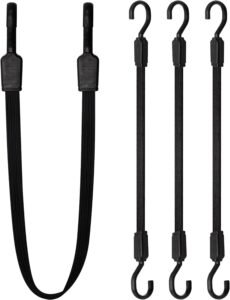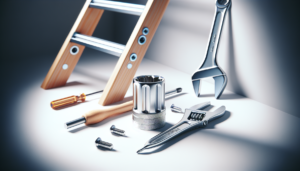
Maintaining a ladder rack is essential for ensuring its longevity and optimal performance. But what exactly is the recommended maintenance schedule for a ladder rack? In this article, we will explore the best practices and guidelines to keep your ladder rack in top shape. From regular inspections to cleaning and lubricating, we will provide you with all the necessary steps to keep your ladder rack functioning smoothly and securely. So, if you want to extend the lifespan of your ladder rack and avoid any unnecessary accidents or damages, read on to discover the recommended maintenance schedule.
Inspecting the Ladder Rack
Checking for Physical Damage
Regularly inspecting your ladder rack is essential to ensure its safety and longevity. Start by thoroughly examining the rack for any signs of physical damage. Look out for dents, cracks, or bends in the metal frame, as these can compromise its structural integrity. Additionally, check for any missing or broken components such as crossbars, brackets, or load stops. Identifying and addressing any physical damage promptly will help prevent accidents and maintain the overall functionality of your ladder rack.
Examining Welds and Joints
Carefully inspect the welds and joints of your ladder rack, as they are critical for its stability and strength. Look for signs of cracks or weak welds, as well as any loose or damaged joints. Ensure that all welds are intact and joints are securely fastened. If you notice any issues, it is advisable to consult a professional or contact the manufacturer for guidance on repairs or replacements. Maintaining the integrity of the welds and joints will help prevent accidents and ensure the safe use of your ladder rack.
Inspecting Fasteners and Mounting Hardware
Inspecting the fasteners and mounting hardware of your ladder rack is essential to ensure that it remains securely attached to your vehicle. Regularly check all nuts, bolts, and screws for tightness and proper alignment. If you notice any loose or missing fasteners, tighten or replace them as needed. Additionally, inspect the mounting hardware, such as clamps or brackets, for any signs of wear or damage. Ensuring the stability of the fasteners and mounting hardware will prevent the ladder rack from becoming dislodged during transportation, reducing the risk of accidents.
Examining Load Stops and Tie-Down Points
Load stops and tie-down points are crucial components of a ladder rack, as they help secure your load during transportation. Take the time to examine the load stops, ensuring they are intact and securely attached to the rack. Check for any signs of wear or damage, such as cracks or missing pieces. Similarly, inspect the tie-down points to ensure they remain robust and functional. If any issues are identified, promptly address them by repairing or replacing the load stops or tie-down points. This will help maintain the safety and stability of your ladder rack while transporting your equipment.
Cleaning the Ladder Rack
Removing Dirt and Debris
Regularly cleaning your ladder rack is necessary to keep it in optimal condition. Begin by removing any dirt, dust, or debris accumulated on the rack. You can use a brush or a high-pressure washer to dislodge stubborn dirt. Pay close attention to hard-to-reach areas where debris may accumulate, such as corners or joints. By removing dirt and debris, you prevent the buildup of corrosive agents and enhance the overall appearance of your ladder rack.
Cleaning with Mild Soap and Water
Once the dirt and debris have been removed, it is time to clean the ladder rack with mild soap and water. Fill a bucket with warm water and add a small amount of mild detergent. Dip a sponge or soft cloth into the soapy mixture and gently scrub the entire surface of the rack. Pay special attention to areas with stains or embedded dirt. Rinse the rack thoroughly with clean water to remove any soap residue. This cleaning method effectively removes grime and leaves your ladder rack looking fresh and well-maintained.
Drying the Rack Thoroughly
After cleaning, it is crucial to ensure that the ladder rack is thoroughly dried. Use a clean, dry cloth or towel to remove any excess moisture from the surface of the rack. If necessary, you can also use compressed air or a leaf blower to speed up the drying process. Leaving the rack wet can lead to the formation of rust or corrosion, compromising its structural integrity. By thoroughly drying the ladder rack, you mitigate the risk of damage and extend its lifespan.
Maintaining the Ladder Rack’s Finishes
Inspecting and Touching-Up Paint
Regularly inspecting the paint finish of your ladder rack is essential to prevent rust and maintain its aesthetic appeal. Look for any chips, scratches, or areas where the paint has worn off. These exposed areas are more susceptible to rust and corrosion. To protect against further damage, touch up the paint using a high-quality rust-resistant paint that matches the original color of your ladder rack. Inspecting and touching up the paint not only enhances the rack’s appearance but also acts as a protective barrier against environmental factors.
Applying Protective Coatings
In addition to paint touch-ups, applying protective coatings can provide an extra layer of defense against rust and corrosion. There are various protective coatings available, such as clear sealants or rust inhibitors specifically designed for metal surfaces. Before applying any protective coating, ensure that the rack is clean and dry. Follow the manufacturer’s instructions carefully and evenly apply the coating to the entire surface of the ladder rack. The protective coating creates a barrier that shields the metal from moisture and other corrosive elements, significantly extending its lifespan.
Preventing Rust and Corrosion
Using Rust Inhibitors
Rust inhibitors are compounds designed to prevent the formation and spread of rust on metal surfaces. Regularly applying rust inhibitors to your ladder rack can help protect it from corrosion caused by exposure to moisture and other environmental factors. Prior to applying a rust inhibitor, clean the rack thoroughly to ensure maximum effectiveness. Follow the manufacturer’s instructions for application, as different rust inhibitors may have specific requirements. By using rust inhibitors, you significantly reduce the risk of rust formation and maintain the structural integrity of your ladder rack.
Applying Wax and Polish
Applying wax or polish to your ladder rack can provide an additional layer of protection against rust and corrosion. Wax creates a barrier that shields the metal surface from moisture and other contaminants, preventing oxidation. Before applying wax or polish, ensure that the ladder rack is clean and dry. Use a soft cloth or applicator pad to evenly apply the wax or polish according to the product instructions. Allow it to dry and then buff the surface to a shine. Regularly applying wax or polish not only enhances the appearance of your ladder rack but also prolongs its lifespan by preventing rust and corrosion.
Avoiding Exposure to Moisture
Moisture is one of the primary causes of rust and corrosion. To prevent these issues, it is crucial to avoid exposing your ladder rack to excessive moisture whenever possible. If the ladder rack becomes wet, ensure that it is thoroughly dried before storing or transporting it. Additionally, avoid leaving the rack in damp or humid environments for extended periods. By taking these precautions, you minimize the chances of rust and corrosion, thus maintaining the performance and safety of your ladder rack.
Regularly Cleaning and Drying
Regularly cleaning and drying your ladder rack is crucial in preventing rust and corrosion. Even if the rack is not visibly dirty, it is still beneficial to clean it periodically to remove any accumulated contaminants. Additionally, ensure that the rack is thoroughly dried after cleaning or exposure to moisture. This routine maintenance practice prevents the buildup of corrosive agents and extends the lifespan of your ladder rack.
Maintaining the Functional Components
Inspecting and Lubricating Moving Parts
Regularly inspecting and lubricating the moving parts of your ladder rack is essential to ensure smooth operation and prevent premature wear and tear. Check all hinges, pivots, and sliding mechanisms for any signs of rust, debris, or excessive friction. If necessary, remove any obstructions and apply a lubricant specifically designed for metal components. Lubricating the moving parts not only improves their functionality but also reduces the risk of damage caused by friction and corrosion.
Checking Latch and Lock Mechanisms
The latch and lock mechanisms of your ladder rack play a crucial role in securing your load during transportation. Regularly check these mechanisms for any signs of wear, damage, or malfunction. Ensure that all latches and locks engage and disengage smoothly and securely. If you notice any issues, such as sticking or jamming, promptly address them by lubricating or repairing the mechanisms. Maintaining the functionality of the latch and lock mechanisms ensures the safe and secure use of your ladder rack.
Testing Rack Adjustments and Operation
Your ladder rack may feature adjustable components that allow you to customize its configuration for different types of loads. Regularly test these adjustable features, such as sliding crossbars or adjustable height settings, to ensure they are functioning correctly. Adjust the rack according to your needs and check that all adjustments lock securely in place. Testing the rack’s operation not only helps maintain its functionality but also ensures the safe and efficient transport of your equipment.
Replacing Damaged or Worn Parts
Identifying Signs of Wear and Tear
Despite regular maintenance and inspections, certain parts of your ladder rack may become damaged or worn over time. It is crucial to identify the signs of wear and tear to prevent accidents and maintain the overall performance of your rack. Look out for rust, excessive play in moving parts, loose connections, or any components that no longer function properly. If you notice any of these signs, consider replacing the damaged or worn parts promptly to ensure the safe use of your ladder rack.
Ordering and Replacing Parts
When replacing damaged or worn parts of your ladder rack, it is important to order high-quality replacement components from reputable manufacturers or authorized dealers. Follow the manufacturer’s guidelines or consult a professional for guidance on obtaining the correct parts for your specific rack model. Ensure that you have the necessary tools and equipment to safely replace the parts according to the manufacturer’s instructions. Properly replacing damaged or worn parts guarantees the continued functionality and safety of your ladder rack.
Consulting Manufacturer’s Guidelines
Manufacturer’s guidelines provide invaluable information on the maintenance, care, and replacement of parts for your ladder rack. Before replacing any components, consult the specific guidelines provided by the manufacturer. These instructions may include detailed diagrams, step-by-step procedures, and safety considerations. Following the manufacturer’s guidelines ensures that you maintain the integrity and performance of your ladder rack, reducing the risk of accidents and prolonging its lifespan.
Storing and Transporting the Ladder Rack
Properly Securing the Rack During Transportation
When transporting your ladder rack, it is crucial to secure it properly to prevent accidents and damage. Use high-quality tie-down straps or ropes to secure the rack tightly to the vehicle. Ensure that the straps or ropes are in good condition and have sufficient tension to prevent any movement or shifting during transportation. Additionally, double-check that all load stops and tie-down points are securely in place. Properly securing the rack during transportation guarantees the safety of both your equipment and other road users.
Storing the Rack in a Dry and Sheltered Area
Proper storage is essential to maintain the condition and functionality of your ladder rack when it is not in use. Ideally, store the rack in a dry and sheltered area to protect it from the elements. This can be a garage, shed, or covered storage space. Avoid leaving the rack exposed to rain, snow, or direct sunlight for extended periods, as these elements can accelerate wear and corrosion. Storing the rack in a dry and sheltered area ensures its longevity and minimizes the need for extensive maintenance.
Covering the Rack to Protect from Elements
If you are unable to store your ladder rack in a fully sheltered area, consider covering it with a suitable weatherproof cover. A cover provides an extra layer of protection against rain, snow, sunlight, and other environmental factors. Before covering the rack, ensure that it is clean and dry to prevent trapping moisture. Secure the cover tightly to prevent it from being blown away by strong winds. By covering the rack, you protect it from the elements and reduce the risk of damage or premature wear.
Safely Using the Ladder Rack
Adhering to Weight Capacity Limits
Every ladder rack has a specified weight capacity limit that must not be exceeded. Adhering to this limit is crucial for the safety and stability of both the rack and your vehicle. Before loading any equipment onto the rack, determine its weight and ensure that it falls within the rack’s capacity. Overloading the rack can lead to excessive stress on the mounting points, compromising its structural integrity and increasing the risk of accidents. Always prioritize safety by respecting the weight capacity limits of your ladder rack.
Using Secure Tie-Downs and Straps
Properly securing your load is essential to prevent it from shifting or falling off during transportation. Use high-quality tie-down straps or ropes that are specifically designed for securing loads. Ensure that the straps or ropes are in good condition, free from any damage or signs of wear. Securely fasten the load to the ladder rack, paying attention to distribute the weight evenly. Regularly check the tension of the tie-downs or straps during transportation. Using secure tie-downs and straps guarantees the safe and secure transport of your equipment.
Avoiding Overloading and Unbalanced Loads
In addition to adhering to weight capacity limits, it is important to avoid overloading or unevenly distributing the load on your ladder rack. Overloading the rack can lead to excessive stress on the mounting points and compromise its stability. Similarly, an unbalanced load can cause the rack to become unstable and increase the risk of accidents. Before loading any equipment onto the rack, ensure that the weight is evenly distributed and does not exceed the recommended capacity. By avoiding overloading and unbalanced loads, you promote the safe use of your ladder rack.
Checking and Adjusting Load before Transport
Before embarking on a journey with your ladder rack, always double-check and adjust the load if necessary. Ensure that all equipment is securely fastened, and there are no loose or protruding objects that may pose a hazard during transportation. If any adjustments or re-securing are required, promptly address them before setting off. Taking the time to check and adjust the load before transport ensures that your equipment remains safely in place and minimizes the risk of accidents.
Keeping the Rack Balanced and Stable
Maintaining the balance and stability of your ladder rack during transportation is crucial for your safety and the safety of others on the road. Avoid any sudden or excessive maneuvers that may cause the rack to sway or shift. Slow down when driving over bumps or uneven terrain to minimize the impact on the rack. Keeping the rack balanced and stable when in motion reduces the risk of accidents and ensures that your equipment remains securely fastened.
Periodic Professional Inspections
Engaging Qualified Inspectors
Periodic professional inspections by qualified individuals can provide an additional layer of assurance regarding the safety and maintenance of your ladder rack. These inspectors have the expertise and knowledge necessary to identify potential issues that may go unnoticed during routine maintenance. Engage a certified professional who specializes in ladder rack inspections to thoroughly assess the condition of your rack and provide recommendations for any necessary repairs or replacements. Periodic professional inspections help ensure compliance with safety standards and reduce the risk of accidents.
Following Manufacturer’s Guidelines
When conducting periodic professional inspections, it is crucial to follow the guidelines provided by the manufacturer. The manufacturer’s guidelines may include specific requirements, checklists, or recommended frequencies of inspections. Adhering to these guidelines ensures that your ladder rack undergoes thorough and comprehensive inspections that address all critical areas. By following the manufacturer’s guidelines during professional inspections, you ensure the safety and maintain the performance of your ladder rack.
Identifying Potential Safety Hazards
During professional inspections, qualified inspectors have the knowledge and expertise to identify potential safety hazards related to your ladder rack. These hazards may include hidden structural damage, worn-out components, or compromised mounting points. By thoroughly examining the rack, the inspectors can detect hidden or minor issues that may pose a safety risk if left unaddressed. Identifying potential safety hazards is essential for the prevention of accidents and the maintenance of a safe working environment.
Addressing and Repairing Any Issues
One of the primary aims of periodic professional inspections is to identify and address any issues found in your ladder rack. If the inspector identifies any safety hazards or areas of concern, it is crucial to promptly address and repair them. Follow the inspector’s recommendations and consult with professionals or the manufacturer for guidance on repairs or replacements. By addressing and repairing any issues identified during professional inspections, you ensure the continued safe and efficient use of your ladder rack.
Documenting Maintenance and Inspections
Maintaining Maintenance Logs
Maintaining a detailed maintenance log is essential for keeping track of the care and maintenance performed on your ladder rack. Create a record that includes the date of each maintenance activity, the specific tasks performed, and any relevant observations or findings. This log serves as a reference for future inspections and helps establish a history of regular maintenance. By maintaining maintenance logs, you demonstrate your commitment to safety and compliance with maintenance requirements.
Recording Visual Inspections
In addition to regular maintenance activities, it is important to conduct visual inspections and record the findings. Visual inspections involve a thorough examination of the ladder rack for any signs of damage, wear, or corrosion. Take photographs or videos of any areas that require attention or repairs. These records serve as visual evidence of the condition of your ladder rack and help identify any changes or deterioration over time. Recording visual inspections provides a comprehensive view of the rack’s condition and assists in planning necessary maintenance or repairs.
Tracking Repair and Replacement History
Keep track of any repairs or replacements performed on your ladder rack, including the date, nature of the repair or replacement, and the parts used. This history provides a detailed account of the maintenance activities undertaken and ensures that you stay up to date with the condition of your rack. By tracking the repair and replacement history, you can identify any recurring issues and make informed decisions regarding future maintenance or upgrades.







